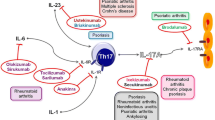Similar content being viewed by others
References
Cook HT and Botto M (2006) Mechanisms of Disease: the complement system and the pathogenesis of systemic lupus erythematosus. Nat Clin Pract Rheumatol 2: 330–337
Datta SK et al. (2005) T-helper cell intrinsic defects in lupus that break peripheral tolerance to nuclear autoantigens. J Mol Med 83: 267–278
Kikly K et al. (2006) The IL-23/Th(17) axis: therapeutic targets for autoimmune inflammation. Curr Opin Immunol 18: 670–675
Hunter CA (2005) New IL-12-family members: IL-23 and IL-27, cytokines with divergent functions. Nat Rev Immunol 5: 521–531
Kramer JM and Gaffen SL (2007) Interleukin-17: a new paradigm in inflammation, autoimmunity, and therapy. J Periodontol 78: 1083–1093
Nakae S et al. (2003) Suppression of immune induction of collagen-induced arthritis in IL-17-deficient mice. J Immunol 171: 6173–6177
Lubberts E et al. (2004) Treatment with a neutralizing anti-murine interleukin-17 antibody after the onset of collagen-induced arthritis reduces joint inflammation, cartilage destruction, and bone erosion. Arthritis Rheum 50: 650–659
McGeachy MJ et al. (2007) TGF-beta and IL-6 drive the production of IL-17 and IL-10 by T cells and restrain T(H)-17 cell-mediated pathology. Nat Immunol 8: 1390–1397
Huber AK et al. (2008) Interleukin (IL)-23 receptor is a major susceptibility gene for graves' ophthalmopathy: the IL-23/T-helper 17 axis extends to thyroid autoimmunity. J Clin Endocrinol Metab 93: 1077–1088
Wong CK et al. (2000) Elevation of proinflammatory cytokine (IL-18, IL-17, IL-12) and Th2 cytokine (IL-4) concentrations in patients with systemic lupus erythematosus. Lupus 9: 589–593
Dong G et al. (2003) IL-17 induces autoantibody overproduction and peripheral blood mononuclear cell overexpression of IL-6 in lupus nephritis patients. Chin Med J (Engl) 116: 543–548
Hsu HC et al. (2008) Interleukin 17-producing T helper cells and interleukin 17 orchestrate autoreactive germinal center development in autoimmune BXD2 mice. Nat Immunol 9: 166–175
Mangini AJ et al. (2007) Type I interferons inhibition of inflammatory T helper cell responses in systemic lupus erythematosus. Ann N Y Acad Sci 1108: 11–23
Korn T et al. (2007) Th17 cells: effector T cells with inflammatory properties. Semin Immunol 19: 362–371
Acknowledgements
This work was partly supported by grants from the National Natural Science Foundation of China (30571608, 30771848) and the Natural Science Foundation of Anhui Province (070413109).
Author information
Authors and Affiliations
Corresponding author
Ethics declarations
Competing interests
The authors declare no competing financial interests.
Rights and permissions
About this article
Cite this article
Pan, H., Ye, D. & Li, X. Type 17 T-helper cells might be a promising therapeutic target for systemic lupus erythematosus. Nat Rev Rheumatol 4, 352–353 (2008). https://doi.org/10.1038/ncprheum0815
Received:
Accepted:
Published:
Issue Date:
DOI: https://doi.org/10.1038/ncprheum0815
- Springer Nature Limited
This article is cited by
-
RNAi Silencing of HIF-1α Ameliorates Lupus Development in MRL/lpr Mice
Inflammation (2018)
-
The Roles of Egr-2 in Autoimmune Diseases
Inflammation (2015)
-
Dominant Th1 and Minimal Th17 Skewing in Discoid Lupus Revealed by Transcriptomic Comparison with Psoriasis
Journal of Investigative Dermatology (2014)
-
Expression of human T cell immunoglobulin domain and mucin-3 (TIM-3) on kidney tissue from systemic lupus erythematosus (SLE) patients
Clinical and Experimental Medicine (2014)
-
Association of FCGR2A-R/H131 polymorphism with susceptibility to systemic lupus erythematosus among Asian population: a meta-analysis of 20 studies
Archives of Dermatological Research (2014)





